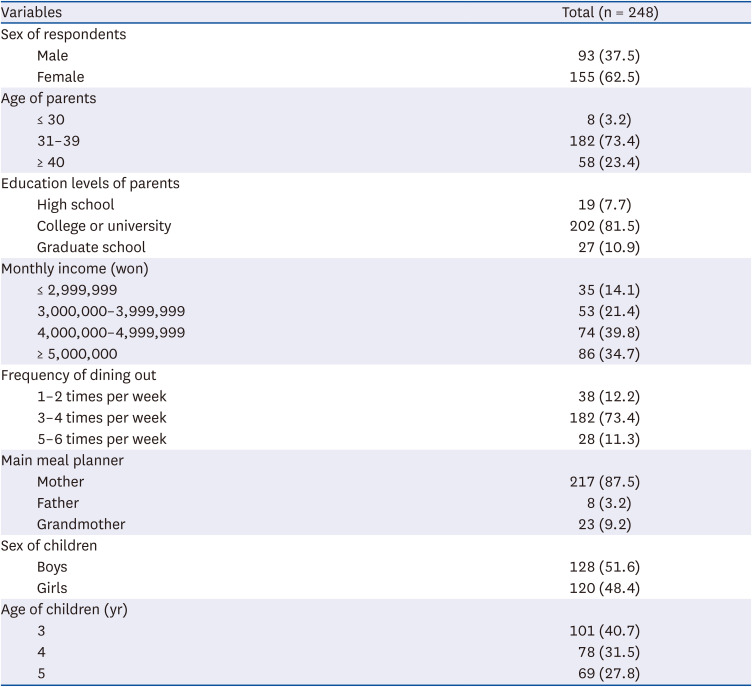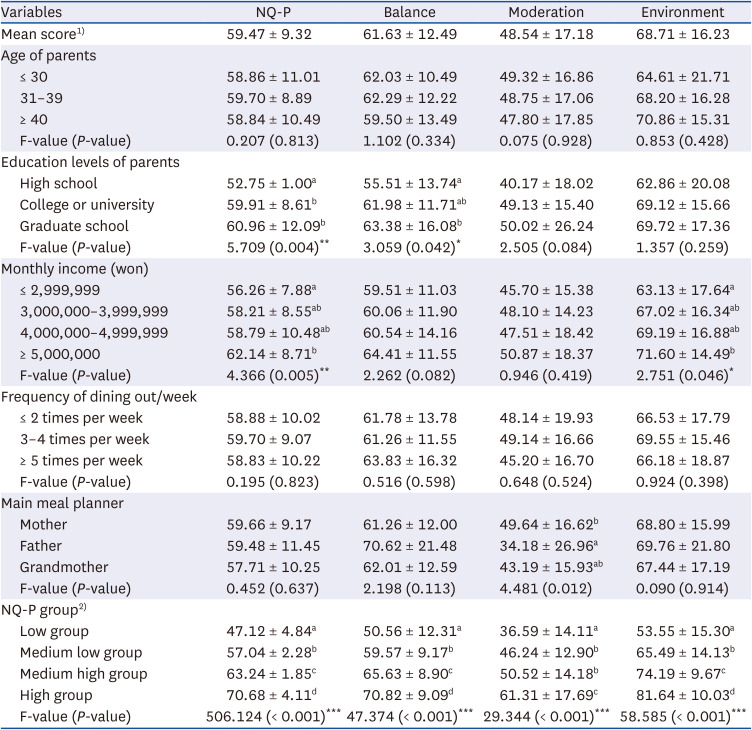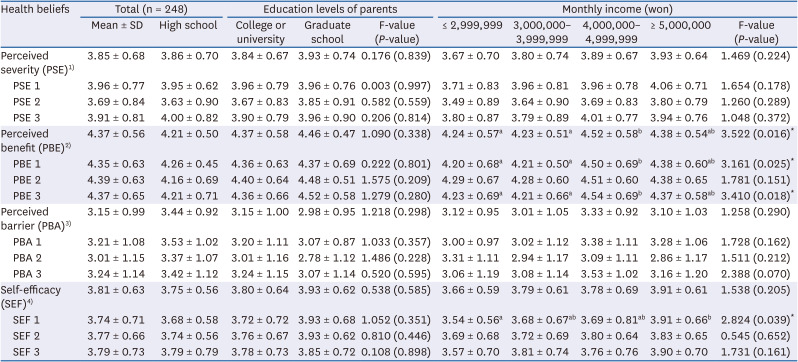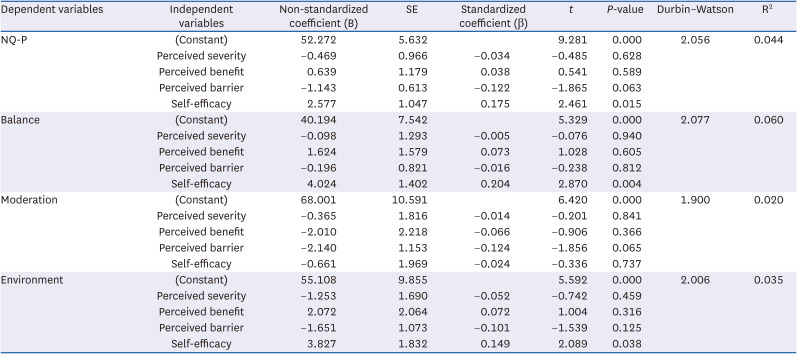1. Andueza N, Navas-Carretero S, Cuervo M. Effectiveness of nutritional strategies on improving the quality of diet of children from 6 to 12 years old: a systematic review. Nutrients. 2022; 14:372–389. PMID:
35057552.
2. Lee JS, Kang MH, Kwak TK, Chung HR, Kwon S, Kim HY, Hwang JY, Choi YS. Development of nutrition quotient for Korean preschoolers (NQ-P): item selection and validation of factor structure. J Nutr Health. 2016; 49:378–394.
3. Kim EK, Song B, Ju SY. Dietary status of young children in Korea based on the data of 2013–2015 Korea National Health and Nutrition Examination Survey. J Nutr Health. 2018; 51:330–339.
4. Sim HM, Han YS, Lee KA. Analysis of the types of eating behavior affecting the nutrition of preschool children: using the Dietary Behavior Test (DBT) and the Nutrition Quotient (NQ). J Nutr Health. 2019; 52:604–617.
5. Jeong IY, Song SJ. Relationship between the dietary behavior of young children and their mothers in Daejeon, Korea using the nutrition quotient for preschoolers and adults. Korean J Community Nutr. 2021; 26:12–22.
6. Kim SY, Cha SM. Evaluation of dietary behavior and investigation of the affecting factors among preschoolers in Busan and Gyeongnam area using nutrition quotient for preschoolers (NQ-P). J Nutr Health. 2020; 53:596–612.
7. Kim SY, Cha SM. Evaluation of dietary behaviors of preschool children in Seoul and Gyeonggi-do associated with the level of parents’ health consciousness: using nutrition quotient for preschoolers (NQ-P). Nutr Res Pract. 2021; 15:248–265. PMID:
33841728.
8. Ministry of Health and Welfare, Korea Centers for Disease Control and Prevention. The Seventh Korea National Health and Nutrition Examination Survey (KNHANES) VIII-2. Cheongju: Korea Centers for Disease Control and Prevention;2020.
9. Kim JH, Jung YH. Evaluation of food behavior and nutritional status of preschool children in Nowon-gu of Seoul by using nutrition quotient (NQ). Korean J Community Nutr. 2014; 19:1–11.
10. Lee HJ, Kim JH, Song SJ. Assessment of dietary behaviors among preschoolers in Daejeon: using nutrition quotient for preschoolers (NQ-P). J Nutr Health. 2019; 52:194–205.
11. Min SH. Evaluation of dietary behavior among preschooler in Jecheon area using nutrition quotient for preschoolers. Korean J Food Cookery Sci. 2018; 34:413–423.
12. Peters J, Parletta N, Campbell K, Lynch J. Parental influences on the diets of 2- to 5-year-old children: systematic review of qualitative research. J Early Child Res. 2014; 12:3–19.
13. Han G, Yang E. Dietary behavior and nutrition quotient (NQ) scores according to the weight status of preschool children in Gwangju metropolitan city. J Korean Soc Food Cult. 2021; 36:412–420.
14. Chun IA, Han MA, Park J, Choi SE, Ryu SY. The association between parental characteristics and dietary habits of early childhood. J Korean Soc Matern Child Health. 2013; 17:150–161.
15. Morrison H, Power TG, Nicklas T, Hughes SO. Exploring the effects of maternal eating patterns on maternal feeding and child eating. Appetite. 2013; 63:77–83. PMID:
23291285.
16. Lee HW, Kim M, Kim H. The impact of family characteristics on children’s meal skip. J Korean Counc Child Rights. 2008; 12:377–399.
17. Jung HY, Ahn JH. The effects of mother’s eating attitude and children’s self-regulation on children’s eating behavior. J Open Parent Educ. 2019; 11:73–88.
18. Kim HA. Influences of the parents’ food habits and health beliefs on child obesity [master’s thesis]. Seoul: Seoul National University;2000.
19. Sameroff AJ, Feil LA. Parental concepts of development. Siegel IE, editor. Parental Belief Systems: The Psychological Consequences for Children. Hillsdale (NJ): Lawrence Erlbaum Associates;1985. p. 83–105.
20. Deshpande S, Basil MD, Basil DZ. Factors influencing healthy eating habits among college students: an application of the health belief model. Health Mark Q. 2009; 26:145–164. PMID:
19408181.
21. O’Connell JK, Price JH, Roberts SM, Jurs SG, McKinley R. Utilizing the health belief model to predict dieting and exercising behavior of obese and nonobese adolescents. Health Educ Q. 1985; 12:343–351. PMID:
4077546.
22. Kang RY, Lee SJ, Ryu HK. Analysis of factors affecting breakfast eating behavior of children in Indonesia: an application of the health belief model. Korean J Community Nutr. 2020; 25:1–12.
23. Choi JH, Lee ES, Lee YJ, Lee HS, Chang HJ, Lee KE, Yi NY, Ahn Y, Kwak TK. Food safety and nutrition education program for elderly and assessment of program effectiveness based on health belief model. J Korean Soc Food Sci Nutr. 2016; 45:1366–1374.
24. Jeong JY, Ham S. Relationships between health beliefs and behavioral intention to use menu labels in restaurants. J Tourism Leis Res. 2016; 28:519–538.
25. Choi DJ. Study on factors related to self-weight control in high school students: based on the health belief model and theory of planned behavior [master’s thesis]. Seoul: Yonsei University;2011.
26. Choi NH, Ahn HS, Lee S. Comparison of health belief levels and health behavior practices according to lifestyle among adults residing in Seoul. Korean J Community Nutr. 2011; 16:683–696.
27. Lee KA. Elementary school children’s perceptions of traditional Korean foods, based on the health belief model. Korean J Nutr. 2013; 46:86–97.
28. Hochbaum GM. Public Participation in Medical Screening Programs: A Socio-Psychological Study (No. 572). Washington, D.C.: US Department of Health, Education, and Welfare;1958.
29. Rosenstock IM. Historical origins of the health belief model. Health Educ Monogr. 1974; 2:328–335.
30. Champion VL, Skinner CS. The health belief model. Glanz K, Rimer B, Viswanath K, editors. Health Behavior and Health Education: Theory Research, and Practice. San Francisco (CA): Jossey-Bass;2008. p. 45–65.
31. Janz NK, Becker MH. The health belief model: a decade later. Health Educ Q. 1984; 11:1–47. PMID:
6392204.
32. Son KM, Park SR, Kim YH. The relationships between transtheoretical model and health belief model to explain exercise behavior. Korean J Phys Educ. 2009; 48:163–173.
33. Keshani P, Hossein Kaveh M, Faghih S, Salehi M. Improving diet quality among adolescents, using health belief model in a collaborative learning context: a randomized field trial study. Health Educ Res. 2019; 34:279–288. PMID:
30915431.
34. Hwang I, Bang KS. Factors affecting obesity and overweight in Korean preschool children: based on the Korea National Health and Nutrition Examination Survey 2013–2014. Child Health Nurs Res. 2016; 22:237–246.
35. Jang HB, Park JY, Lee HJ, Kang JH, Park KH, Song J. Association between parental socioeconomic level, overweight, and eating habits with diet quality in Korean sixth grade school children. Korean J Nutr. 2011; 44:416–427.
36. Kim KR, Hong SA, Kim MK. Nutritional status and food insufficiency of Korean population through the life-course by education level based on 2005 National Health and Nutrition Survey. Korean J Nutr. 2008; 41:667–681.
37. Jung YH, Kim JH. Evaluation of nutrition quotient and related factors in preschool children. Korean J Community Nutr. 2016; 21:1–11.
38. Nicklas TA, Baranowski T, Baranowski JC, Cullen K, Rittenberry L, Olvera N. Family and child-care provider influences on preschool children’s fruit, juice, and vegetable consumption. Nutr Rev. 2001; 59:224–235. PMID:
11475448.
39. Bae JM, Kang MH. Age difference in association between obesity and nutrition quotient scores of preschoolers and school children. J Nutr Health. 2016; 49:447–458.
40. Na SY, Ko SY, Eom SH, Kim KW. Intakes and beliefs of vegetables and fruits, self-efficacy, nutrition knowledge, eating behavior of elementary school students in Kyunggi area. Korean J Community Nutr. 2010; 15:329–341.
41. Dumitrescu C, Lacob CI. Predicting healthy eating: Conscientiousness versus the health belief model. Rom J Appl Psychol. 2021; 23:18–24.
42. Bandura A. Self-efficacy: toward a unifying theory of behavioral change. Psychol Rev. 1977; 84:191–215. PMID:
847061.









 PDF
PDF Citation
Citation Print
Print



 XML Download
XML Download